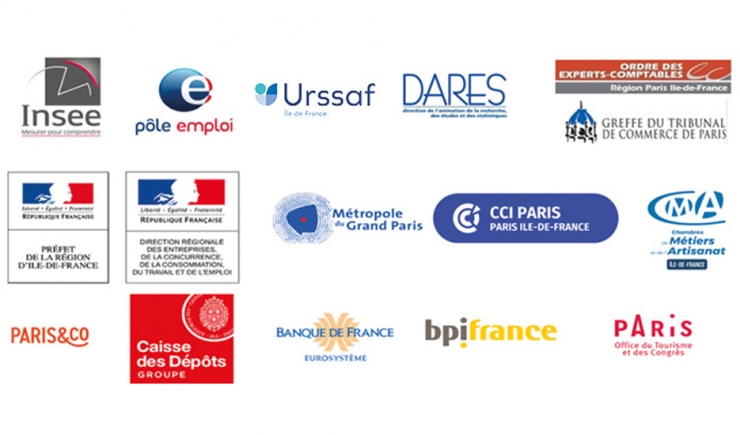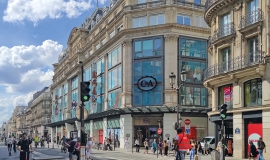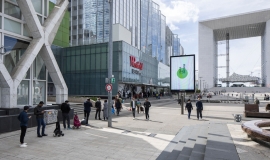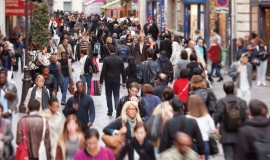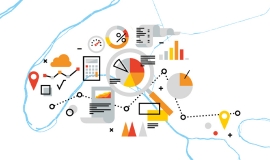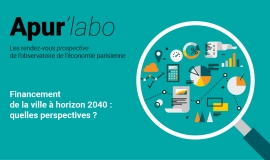This partnership observatory is dedicated to analysing specific characteristics of the Parisian economy and assessing the impacts of the health and economic crisis linked to Covid-19.

- Part 1 - Trend data
- Part 2 - In-depth thematic research (in french)
- Part 3 - Economic Forecasting Lab (in french)
Put in place in 2021, the Observatory’s mission is to analyse specific aspects of the Parisian economy and to evaluate the economic impact of the crisis on companies according to their sector of activity, employment, job demand and the effects of support measures. It also aims to develop a more forward-looking approach to reflection on how to support recovery, anticipate changes in the economy and imagine developments to enhance the future.
It enables information to be shared on a regular basis between all partners, statistical exercises to be produced that make it possible to measure the ongoing effects of the crisis and in-depth thematic research to be carried out. The aim is to be able to adapt and coordinate the responses provided, based on this shared information.
The Observatory deals with Paris, the heart of the Greater Paris - Grand Paris Metropolis - and Ile-de-France Region but is also a world-class capital city, within the network of the world’s largest metropolises.
Run by Apur, (the Paris Urbanism Agency) and the City of Paris’ Department of Attractiveness and Employment (DAE), the Observatory is a space for partnership thinking, which takes form collectively among more than thirty key players of the Parisian economy. It was presented on 8th February during the Economic and Social Conference organised at the initiative of the Mayor of Paris.
It consists of three parts:
- A first part linked to monitoring economic trend indicators which measure and analyse the effects of the crisis on an ongoing basis.
- A second part which involves in-depth thematic consideration of priority issues and specific sectors of the Parisian economy.
- A third part aims to develop more forward-looking thinking to accompany the recovery and anticipate changes in the Parisian economy.
PART 1 - ECONOMIC TREND DATA
Method
In order to analyse specific aspects of the Parisian economy and to assess the economic impact of the crisis, the Observatory relies on multitude data sources, as well as data relating to the support measures put in place.
These data are organised under 7 themes: decline in activity, employment trends, unemployment - RSA benefit, business start-ups and failures, the most affected business sectors, aid and support measures, long-term impact.
The Observatory enters into the timeframe and the metropolitan territory, with data mobilised on the scale of Paris, the Grand Paris Metropolis, Ile-de-France and sometimes on a finer scale depending on the indicators (districts (arrondissements), municipal communes, the City of Paris Urban Cohesion Policy districts, etc.). The economic trend data are updated quarterly.
Data compiled during the 2020, led to a specific analysis note published at mid-year.
Implementation of the Observatory involves developing a dynamic tool for sharing economic trend data and producing thematic analyses in the form of notes or studies. It also gives rise to regular meetings with partners to share the main results.
PART 2 - IN-DEPTH THEMATIC RESEARCH
Method
In-depth thematic research is carried out in liaison with the Observatory’s partners on priority issues and sectors particularly impacted by the crisis. Apur and the DAE request that partners particularly concerned by each subject, organise workshops and contribute to producing analysis notes and summaries of the exchanges.
Similarly to trend data, the overviews of thematic databases are researched at several scales depending on the available sources and the issues at stake: Paris, districts, Grand Paris Metropolis, and even, when relevant, specific scales such as the Grand Paris Express station neighbourhoods.
3 core sectors
- Commerce
How can local shops be revitalised, including the development of e-commerce? Is digitalisation the way for street level, retail outlets to resist? Commercial property? The evolution of the luxury goods and fashion sector.
- Tourism linked to the Paris Sustainable Tourist Conference
Recover numbers but act to encourage the emergence of a more local model (diffusion of the flow of tourists, development of tourism by the inhabitants of Ile-de-France and Paris) which is more sustainable (encourage longer visits, arrivals by train, particularly night trains, optimise the impact on employment and the local economic fabric), and therefore more resilient.
- Culture
To accompany reopening to the public, revitalise what exists already as well as associating the production of digitalised content (how to attract people to Paris on networks and the ecosystem of major key players and specialised schools - École des Gobelins etc.).
4 levers
- Innovation
What changes are taking place in main core sectors of the Parisian economy? What new innovative sectors? Changes in the world of banking, insurance and green finance with neobanking and cryptocurrencies. What industrial and productive sectors will have (re)found a place in the city in 20 years time? Under what conditions? Manufacturing in the city: robotics, 3D printers.
- Social and solidarity economy
Citizen involvement/How to encourage local spin-offs, in terms of local, social and environmental impact, of companies and economic key players? How can these criteria be integrated into support measures?
- Circular economy / Short circuits
Food, urban agriculture. recycling-reuse. The construction sector between industrialisation and craft industry, the reduction of waste produced, zéro plastic. Local consumption and short circuits: which sectors, what places and type of production, which jobs, what training?
- Public procurement
Use of public procurement to promote an impact economy, with local players, VSBs/SMBs and SSE players, etc.
PART 3 - ECONOMIC FORECASTING LAB
Method
This lab aims to strengthen the forward-looking aspect of the Observatory’s work in order to prepare for the end of the crisis and to define the principal guidelines for a 2040 time horizon. The project aims to carry out scientific work on the major economic issues of the future, by mobilising a pool of competent experts on various different subjects (Labor chair, members of the City of Paris Scientific Council, researchers, economists, lawyers, geographers, etc.).
A work agenda is set biannually to produce a “state of the art” (state of knowledge, research, visions) and to lead to exchanges in small format as well as during larger conferences with high-level experts. The format of this circle of experts varies according to the theme being treated.
Since the summer 2021, this work has been launched around 3 themes:
1. The financial structure of a city, with a 20 year time horizon:
- What will be the main sources of funding for a local authority like Paris in 20 years time?
- Development of revenue linked to in-place economy, role and weight of local taxes, changes in expenditure and priorities for action, debt management, the impact of public procurement.
- How to define the sustainability of the public municipal debt?
2. New strategic economic sectors and the employment of tomorrow:
- Which sectors will provide jobs in Paris in the future? What new jobs?
- How to adapt? The challenges of professional training and reconversion.
- Which industrial and productive sectors will be found in Paris in 20 years time?
- The evolution of the world of banking and insurance.
- Manufacturing in a city: robotics, 3D printers, crafts.
- Recycling, reduction of waste production, zero plastic.
- Food, urban agriculture, short circuits.
- Health, ageing, dependancy, the silver economy.
3. The fight against inequality, a factor in the development of territories:
- The “care” society and its challenges.
- New forms of work and the need for social protection (cf. umbrella freelance administration companies, cooperative model).
- Educational policies at the centre of the fight against inequalities.

